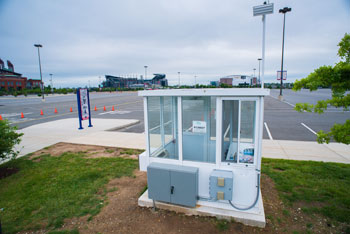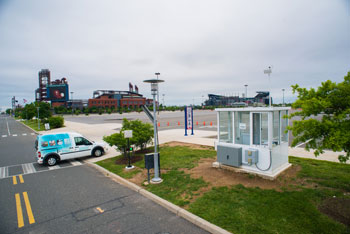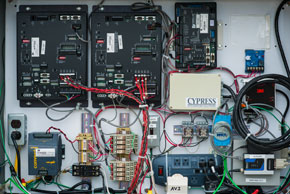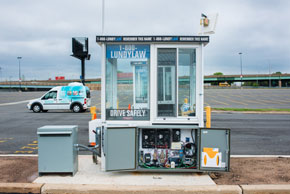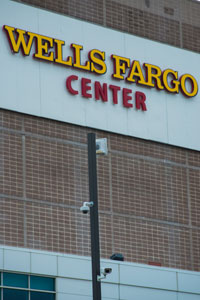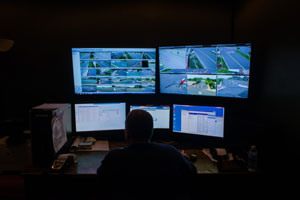
|
|
The vast parking system at the Philadelphia Sports Complex, with 17,000 parking spaces and 42 lanes across 13 lots, accommodates customers for more than 300 events each year. All photos by William Thomas Cain/Cain Images
|
CASE STUDY: PHILADELPHIA SPORTS COMPLEX
Three companies partner to bring sophisticated event parking system to the Philadelphia Sports Complex.
RICHARD N. BEST ASSOCIATES, INC.
3M PARKING | ZIPPARK, INC.
The Philadelphia Sports Complex overhauled its manual and primarily cash-based parking operations, implementing a sophisticated revenue control system for event parking. The parking management company, SP+, realized that by embracing new technology, operations could achieve greater speed, efficiency and accuracy, while offering a wider range of payment methods. Management would benefit from real-time data analysis and increased security, and all of the improvements would combine to enhance the overall customer experience.
This huge complex in South Philadelphia may be the largest sports and entertainment venue in North America. Encompassing Citizens Bank Park, Lincoln Financial Field, Wells Fargo Center and XFINITY Live!, the Philadelphia Sports Complex is the only venue where four major sports teams — the Philadelphia Phillies, Eagles, 76ers and Flyers — play on a single footprint. To accommodate customers for more than 300 events each year, there are 17,000 parking spaces and 42 lanes. Parking operations are controlled by a joint venture between Spectrum Arena LP and Phillies Ballpark LP, and managed by SP+ (which also operates some locations as Central Parking and Standard Parking).
THE SITUATION
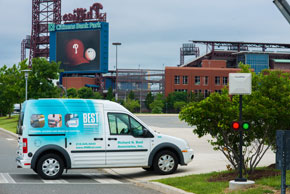 |
|
The Philadelphia Sports Complex includes Citizens Bank Park, Lincoln Financial Field, Wells Fargo Center and XFINITY Live!, home of four major sports teams – the Philadelphia Phillies, Eagles, 76ers and Flyers. |
For decades, parking for events at the Philadelphia Sports Complex operated on a cash-based system. Until the recent upgrade to improve revenue control in the spring of 2014, operations utilized a team of cashiers, supervisors and couriers to handle a mix of cash and prepaid passes. Facility owners and operators knew an upgrade to the latest technology would increase the speed of transactions and reconciling, improve accuracy, heighten efficiency, and offer customers a smoother entrance.
SP+ sought a vendor with experience in multi-platform event parking solutions. Expectations were for the vendor to develop a technical proposal and plan, provide equipment pricing with warranty guarantees, and supply a service plan and pricing, including two years of on-site event support after initial deployment, and a help desk to provide technical support. In addition to the ability to process credit card transactions, SP+ wanted its new system to utilize handheld computers and printers, AVI readers, facility management software, computerized count equipment, an IP video surveillance system, back office reporting software, and a dashboard for improved operator management. The prevalence of prepaid passes warranted the new system to distinguish between multiple formats of prepaid parking credentials.
Initial goals were to:
- Decrease overall entry times / improve traffic flow.
- Expand customer choice through varying payment types.
- Increase and expedite revenue control.
- Improve management through real-time data analysis.
THE PARTNERS/THE TEAM
Three separate companies, all with specialized expertise, joined together to submit the winning proposal, resulting in a new collaboration between Richard N. Best Associates, Inc. (RNB), 3M Parking and ZipPark, Inc. RNB provided project coordination and performed the complete installation. 3M supplied the facility management system, ramp controllers (for vehicle counts) and system interface responsibility. ZipPark outfitted the event system, featuring Motorola MC75 handheld computers allowing attendants to accept credit cards in all entry lanes, and adding the capability of instantly processing event passes from websites such as New Era, Tickets.com and Click and Park®.
|
||
Although RNB and ZipPark have worked parallel in the same industry for years, this project represented their first official collaboration. Carl Sgamboti, Chief Operating Officer at ZipPark, explains the challenges presented at the onset of the project. “The enormity of the site is difficult to grasp,” he says. “The Philadelphia Sports Complex has more than 300 events a year. That’s a lot of revenue, tickets and vehicles to keep track of with an average of 6,000 vehicles per event.”
Sgamboti explains that before the upgrades, the system was primarily cash-based. “The cashier would tear a ticket off a stack, tear off a receipt, retain the other part, and let the driver proceed through the lane. As a vehicle entered the lot, it was driven over a counting device, affectionately called a ‘hog,’ essentially a metal stick pointing up in the air. The hog would count the vehicle, then rise back up again for the next customer. At end of the night, staff would have to gather up all the tickets, compare to the hog count, and reconcile that number with the cash and passes to make sure everything matched. If not, they had a problem.”
|
|
Innovative interface control units contain the wiring between the complex equipment. Richard N. Best Associates enclosed “the smarts and parts” within weather resistant boxes attached to the sides of the booths, where wiring and equipment is neatly contained and readily accessible for maintenance and repair.
|
Every day, the system would count every vehicle: paying customers, taxis, police cars, ambulances, VIPs and season ticket holders. This created loopholes in the system with discrepancies often arising between the actual count and reconciled revenue.
In addition, Sgamboti explains that there were “72 different types of prepaid passes. When a customer used a prepaid pass, the cashier simply accepted it because there was no way to determine at entry whether the pass was valid. Then they would retain a tear-off stub or write down the number in a log. This had to occur in 42 lanes across 13 lots with a line of fans anxious to get to the game. After the event, they needed to reconcile and audit 72 different piles of passes on manual spreadsheets. If there was a discrepancy, they needed to figure out why."
THE PLAN AND EQUIPMENT
SP+ specifically asked for a dashboard in the Command Center to display information in real time from handheld computers and loop detectors, a system of wire loops in the asphalt to detect and count vehicles. Regardless of the payment method, all transactions would run through the handheld units, feeding the data into the integrated network.
The project team sourced a broad range of state-of-the-art equipment to install a centralized monitoring and accounting system, complete with custom interface control units designed by RNB technical staff. For wireless infrastructure to provide complete connectivity between all lots, handhelds, and cameras, the team tapped Wireless Resources, Inc. In order to source the AVI readers, the team turned to TransCore, enabling the processing of EZPass tags for local access. Adams Electric connected the components with high-voltage wiring, including booths and the video monitoring system, feeding them into the centralized network. Adnet Technologies, LLC provided the servers and workstations, configured to meet the stringent requirements of PCI-DSS to safeguard cardholder data. The result was a solution of extraordinary value to the operator, meeting all requirements and retaining the ability to adapt to changing needs.
The new system is completely wireless, enabling all new electronic devices to instantly communicate through a wireless backbone, wrapping data from each parking transaction into one cohesive system. The powerful, web-based zControl software and proven hardware components provide real-time management over the wireless network. The user-friendly, intuitive interface seamlessly allows the administrator to observe every detail across multiple lots, even with simultaneous events, variable rate structures and dozens of categories of pre-paid passes. 3M’s Facility Management System provides real-time vehicle counting and controls access for patrons with RFID transponders.
The sophisticated CCTV system is geared to focus on exceptions to verify decisions made at the booth. If a cashier performs a transaction for a non-paying vehicle, such as a taxi or emergency vehicle, it appears on the dashboard immediately for management to review. Administrators in the Command Center can focus a camera and zoom in on the lane, visually ensuring that the correct decision has been made at the booth.
|
||
Tying together the various systems, Richard N. Best Associates designed innovative interface control units to house and connect wiring between the elaborate equipment. RNB Vice President Terry Dun prevailed with his idea to house “the smarts and parts” within weather resistant boxes attached to the sides of the booths. Originally, these boxes had been slated to be located on poles throughout the site. “An uncoordinated installation would have this stuff all over the booths, literally hundreds of connections susceptible to weather or physical damage,” says Don Vennell, RNB Account Executive. Instead, the wiring and equipment is neatly contained and readily accessible for maintenance and repair.
|
|
Poles throughout the site support the network with wireless dish antennas and a sophisticated system of video cameras.. |
ZipPark designed and wrote the software for the dashboard. ZipPark’s system also imports pre-paid passes from major ticket outlets such as Tickets.com, New Era and Click and Park®. Passes are downloaded to the handheld computers and updated in real time so that even customers who purchase parking upon arrival at the ticket office can use their pass minutes later to enter a lot.
In addition, the ZipPark system uploads scanned passes back to Tickets.com in real time so Tickets.com and the Phillies’ customer service departments know exactly what’s happening in the field during the event. Sgamboti explains: “If a customer calls in, reps are empowered with real-time information about that customer’s pass, where and when it was scanned, and even which cashier scanned it. If the ZipPark handheld determined the pass was invalid, the reason is available too.”
FULFILLING PROJECT GOALS
The RNB/3M/ZipPark team collaborated to build a new Philadelphia Sports Complex parking system, controlled by a sophisticated Command Center with real-time dashboard display, on a wireless backbone with complex infrastructure.
Traffic flow is improved and overall entry times are slashed by the use of handheld computers to accurately process a wide variety of payment types in seconds. In fact, credit card transactions under the new system are authorized in, on average, three to five seconds, according to Carl Sgamboti.
|
||
“The initial goals were to improve controls and improve customer service. Those two things have already happened,” says Chris Sherman, Senior Vice President of SP+. “We have faster ingress, multiple payment options and a control room that’s able to see what’s going on and track exceptions in real time.” Regarding implementation of sales via cash, credit card and prepaid barcode, “all three are working well, and the credit card processing times have exceeded expectations."
To record a cash payment, attendants simply push a button. To admit VIPs (as many as 200 per game), the team offices send names to the operator, which are imported to the system and sent to the handheld units. Season ticket holders, along with customers who pre-purchased tickets on websites or via cell phone, will find their digital information waiting at the gate and experience rapid, hassle-free passage through the lane. The handheld unit scans the barcode, validates the pass, and confirms that the customer is at the right event on the proper date. It also confirms the pass has not already been used, preventing fraud and abuse.
Fans parking for games have been pleasantly surprised by the new system. Sherman says customers, for the most part, are satisfied. “Many of the Flyers fans use passes, and they were happy with the new system. People are pleased to be able to use credit cards, and appreciate how it speeds up the process,” he notes, then adds: “Some people are not happy: the ones who used to duplicate their passes!” At times, 10-15 duplicate passes per game have been presented since the new system has been in operation.
“They’ve locked down the system so people aren’t playing games,” says Terry Dun, RNB Vice President, “and because cashiers are not holding large amounts of cash, they are safer from the threat of robbery."
REAL-TIME MANAGEMENT
At the heart of the new system is a Command Center with dashboard, which controls, monitors and manages all data in real time.
“The exciting thing is the amount of information that is now at their fingertips,” says Barry Lazowski, ZipPark’s President. “The system we put in place combines an array of different technologies – loops in the lane that do the counting, handhelds to record every single type of transaction, video cameras in all lanes.”
|
||
“They can now accurately count every vehicle coming in and compare with transactions in the handhelds,” says Don Vennell. “On a busy day, there will be vehicles for multiple events filling the 17,000 parking spaces, with all transactions being done through the handhelds, and followed on the dashboard in real time.”
Each time a cashier pushes a button on a handheld to record a transaction, it appears seconds later on the dashboard. “If a vehicle enters a lane without a corresponding handheld transaction, a red light shows up – they know there’s an issue – they can track it down to exact lane and go to the video camera for that lane and see what happened,” explains Lazowski. “It helps with validation – if for any reason someone is going through without paying full price, it will show up as a special exception.”
It is vital to track, collect and catalog data on these exceptions “since they are open to manipulation,” Sherman says. “For example, if a cashier hits the button for ‘police’, it’s tracked on the dashboard in real time. You can look up at the cameras and see if there is a police car there. There is also a ‘go back’ feature. At a later time, you can go back and track that there were three separate police cars in Lane 2 at precisely 7:00, 7:25 and 7:56.” In the past, the “go back” system relied on supervisors monitoring the lanes and working from memory alone.
STREAMLINED REVENUE CONTROL
|
|
At the heart of the new system is a Command Center with dashboard, which controls, monitors and manages all data in real time.
|
Reconciling at the end of the night is now a breeze. The auditing process is “a lot quicker and a lot more accurate,” says Dave McFadden, SP+ Senior Operations Manager for the sports complex. Instead of requiring staff to reconcile ticket stubs and manual vehicle counts by hand, “all they have to do is go to the handheld and log out a report.”
“A higher level of revenue/audit control is achieved through the integration of this information to the dashboard,” says Vennell. “For example, the number of handheld transaction counts plus AVI vehicle counts should equal the total number of vehicles in the lot. 3M provides all lane vehicle counts, ZipPark provides transaction counts from the handhelds; overhead cameras provide real-time visual awareness; WRI provides wireless infrastructure that communicates with the Command Center. The ZipPark handhelds can process credit cards and cash, as well as pre-printed barcode parking passes patrons can print at home from New Era, Tickets.com and Click and Park®. All of these avenues count revenue and data in real time.”
Chris Sherman of SP+ explains an additional procedure to lock down the parking system. “There are electronic safes in each plaza. Attendants place bills in the safe and the unit automatically reports to the dashboard how much cash is on hand. So for four lanes, if the system says you should have $20,000 in cash, you know how much is in the safe via real-time review. The only people who can open the safe are the couriers.”
TRAINING AND ROLLOUT
Through proactive communication with all vendors and staff, the project team worked to adapt and refine the process throughout the implementation and rollout of the new system. Just as the project was finishing up and going live, Todd Rosen, SP+ Regional Manager, was transferred to Philadelphia.
“Todd Rosen spent an unbelievable amount of time at the complex when we went live. He was there every day,” recalls Terry Dun.
Rosen appreciated RNB's efforts to tie everything together: “Of everybody involved, RNBest was the most hands-on, accommodating anything we wanted to change, and helping us troubleshoot everything,” Rosen says.
“Dave McFadden, SP+ Senior Operations Manager at the sports complex, was great to work with,” says Dun. “Dave worked hard to make sure we had everything we needed to make this project a success.”
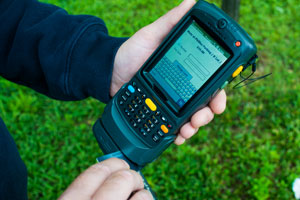 |
|
Credit card transactions under the new system are authorized in, on average, three to five seconds, according to ZipPark’s Carl Sgamboti. Motorola MC75 handheld computers accept credit cards in all entry lanes, while also accounting for prepaid passes and event passes from websites such as New Era, Tickets.com and Click and Park®. |
Lazowski says he expected cashiers to take to the handhelds quickly. “The learning curve is so easy – you can train people in a very short period of time, and they’re off and running.” This is important, he adds, because “the parking industry has a very high employee turnover rate, so a system that requires little training for proficiency is a major benefit to parking operators.”
Rosen describes the training procedures to facilitate smooth implementation of new technologies, which included establishing a precise set of procedures to help employees maintain peak efficiency. “One thing we did was to oversee the cashiers, pinpoint who’s catching on and have the employees working most efficiently train the others so there is a uniform system in place,” he says.
Sherman says that during the rollout, “a lot of different things came to light – little things change the operation. For instance, how do you give change when you have a handheld in one hand?”
As the project moves forward, Sherman acknowledges improvements will continue to be made. For instance, to further speed operations, enhance customer service and reduce operational costs, Sherman said SP+ will give fans the opportunity to use EZPass or order an AVI credential. “We have a captured audience and we can get to that fan base,” he said. “Our next step is having a marketing plan go out to each team’s fan base and get them to register.”

![]()
Home | Send To A Friend | Site Map | Privacy Statement
© Copyright 2010 Richard N. Best Associates, Inc. All Rights Reserved.

